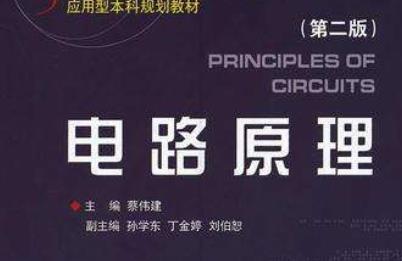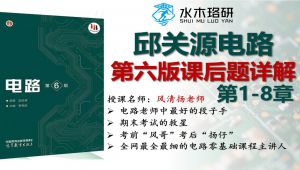- 0.1支路变量、元件、KCL和KVL 数学基础知识(Math basics for circuits)(1)
- 0.2数学基础知识(Math basics for circuits)(2)
- 0.3数学基础知识(Math basics for circuits)(3)
- 0.4数学基础知识(Math basics for circuits)(4)
- 0.5数学基础知识(Math basics for circuits)(5)
- 0.6数学基础知识(Math basics for circuits)(6)
- 0.7数学基础知识(Math basics for circuits)(7)
- 1.1为什么要学习电路(why learn circuits_) 为什么要学习电路(why learn circuits_)(1)
- 1.2为什么要学习电路(why learn circuits_)(2)
- 2.1电路(circuits) 电路(circuits) 1电路(circuits) 电路(circuits)(1)
- 2.2电路(circuits) 电路(circuits) (2).
- 3.1支路变量(branch variables) 支路变量(branch variables) (1)
- 3.2 支路变量(branch variables) (2).
- 3.3支路变量(branch variables) (3)
- 3.4 支路变量(branch variables) (4)
- 3.5支路变量(branch variables)
- 3.6支路变量(branch variables)
- 4.1 参考方向(reference direction) 参考方向(reference direction)
- 5.1功率(power) 功率(power)
- 6.1 电阻(resistor) 电阻(resistor)
- 6.2电阻(resistor)
- 7.1 独立电源(independent source)(1)
- 7.2 独立电源(independent source)(2)
- 7.3 仿真1(simulation1)
- 8.1 端口(port)
- 9.1 受控元件(dependent elements)(1)
- 9.3 受控元件(dependent elements)(3)
- 9.4 仿真2(simulation2)
- 10.1 基尔霍夫定律(KCL KVL) 基尔霍夫定律(KCL KVL)
- 10.2基尔霍夫定律(KCL KVL)
- 10.3基尔霍夫定律(KCL KVL)
- 10.4基尔霍夫定律(KCL KVL)
- 11.1 2B法(2B method) 2B法(2B method)
- 12.1电阻、电源的等效变换(Equivalent transform for resistors and sources) 电阻的串并联(serial pa
- 12.2电阻的串并联(serial parallel resistors)
- 12.3电阻的串并联(serial parallel resistors)
- 12.4电阻的串并联(serial parallel resistors)
- 13.1 平衡电桥(bridge) 平衡电桥(bridge)
- 13.2电桥实验
- 14.1 Y-Δ变换(Y-Δ transform) Y-Δ变换(Y-Δ transform)
- 14.2Y-Δ变换(Y-Δ transform)
- 15.1 二端网络的等效电阻(equivalent resistance of two-terminal network) 二端网络的等效电阻(equivale
- 16.1电源的等效变换(equivalent transform for sources) 电源的等效变换(equivalent transform for s
- 16.2电源的等效变换(equivalent transform for sources)
- 16.3电源的等效变换(equivalent transform for sources)
- 17.1最大功率传输(maximum power transfer) 最大功率传输(maximum power transfer)
- 18.1运算放大器(Op Amps) 运算放大器(Op Amps)
- 19.1运算放大器模型(Op Amps model) 运算放大器模型(Op Amps model)(1)
- 19.2运算放大器模型(Op Amps model)(2)
- 19.3运算放大器模型(Op Amps model)(3)
- 19.4仿真3(simulation3)
- 20.1理想运算放大器(ideal Op Amp) 理想运算放大器(ideal Op Amp)
- 21.1 第21讲 运算放大器的应用 运算放大器的应用(applications of Op Amps)(1)
- 21.2运算放大器的应用(applications of Op Amps)(2)
- 21.3运算放大器的应用(applications of Op Amps)(3)
- 21.4运放电流源实验
- 22.1 数字系统介绍(digital system —— introduction) 数字系统介绍(digital system —— introductio
- 23.1数字系统——数和逻辑(digital system——number and logic in digital) 数字系统——数和逻辑(digital s
- 23.2数字系统——数和逻辑(digital system——number and logic in digital)(2)
- 24.1金属-氧化层半导体场效晶体管(MOSFET) 金属-氧化层半导体场效晶体管(MOSFET)(1)
- 24.2金属-氧化层半导体场效晶体管(MOSFET)(2)
- 25.1逻辑门(logic gates) 逻辑门(logic gates)(1)
- 25.2逻辑门(logic gates)(2)
- 26.1互补金属氧化物半导体(CMOS) 互补金属氧化物半导体(CMOS)
- 27.1二端口网络(two-port network)(不要求) 二端口网络(two-port network)
- 28.1 G参数(G parameter)(不要求)G参数(G parameter)(1)
- 28.2 G参数(G parameter)(2)
- 29.1其他参数(other parameters)(不要求) 其他参数(other parameters)(1)
- 29.2其他参数(other parameters)(2)
- 29.3其他参数(other parameters)(3)
- 30.1二端口网络的等效电路(equivalent circuits of two-port)(不要求) 二端口网络的等效电路(equivalent circu
- 31.1 二端口网络的连接(connection of two-ports)(不要求) 端口网络的连接(connection of two-ports)(1)
- 31.2二端口网络的连接(connection of two-ports)(2)
- 31.3二端口网络的连接(connection of two-ports)(2)
- 32.1系统化方程解法介绍(introduction to systematic function formulating) 系统化方程解法介绍(introdu
- 33.1节点电压法(node voltage method) 节点电压法(node voltage method)(1)
- 33.2节点电压法(node voltage method)(2)
- 34.1 回路电流法(loop current method) 回路电流法(loop current method)(1)
- 34.2回路电流法(loop current method)(2)
- 34.3回路电流法(loop current method)(3)
- 35.1叠加、替代和戴维南定理 (Superposition substitution and Thevenin ) 叠加定理(superposition t
- 35.2叠加定理(superposition theorem)(2)
- 35.3叠加定理(superposition theorem)(3)
- 35.4叠加定理(superposition theorem)(4)
- 36.1戴维南和诺顿定理(Thevenin_Norton theorem) 戴维南和诺顿定理(Thevenin_Norton theorem)(1)
- 36.2戴维南和诺顿定理(Thevenin_Norton theorem)(2)
- 36.3戴维南和诺顿定理(Thevenin_Norton theorem)(3)
- 36.4戴维南和诺顿定理(Thevenin_Norton theorem)(4)
- 36.5戴维南定理实验
- 37.1戴维南定理的应用(applications of Thevenin theorem) 戴维南定理的应用(applications of Thevenin
- 37.2戴维南定理的应用(applications of Thevenin theorem)(2)
- 37.3戴维南定理的应用(applications of Thevenin theorem)(3)
- 38.1第38讲 替代定理(substitution theorem) 替代定理(substitution theorem)
- 39.1 非线性电阻电路(Nonlinear resistive circuits) 非线性电阻(nonlinear resistor)(1)
- 39.2非线性电阻(nonlinear resistor)(2)
- 40.1非线性电阻电路的方程求解法和图解法(analytical and graphical methods for nonlinear circuits) 非
- 40.2非线性电阻电路的方程求解法和图解法(analytical and graphical methods for nonlinear circuits)(2
- 41.1非线性电路的分段线性法(piecewise linear method for nonlinear circuits)____非线性电路的分段线性法(
- 41.2非线性电路的分段线性法(piecewise linear method for nonlinear circuits)(2)
- 41.3非线性电路的分段线性法(piecewise linear method for nonlinear circuits)(3)
- 41.4 非线性电路的分段线性法(piecewise linear method for nonlinear circuits)(4)
- 41.5非线性电路的分段线性法(piecewise linear method for nonlinear circuits)(5)
- 42.1假设检验法的应用(application of suppose-verify method) 假设检验法的应用(application of suppo
- 42.2假设检验法的应用(application of suppose-verify method)(2)
- 43.1非线性电路的小信号法(small signal method for nonlinear circuits) 非线性电路的小信号法(small sign
- 43.2非线性电路的小信号法(small signal method for nonlinear circuits)(2)
- 43.3非线性电路的小信号法(small signal method for nonlinear circuits)(3)
- 44.1 小信号模型(small signal models) 小信号模型(small signal models)(1)
- 44.2小信号模型(small signal models)(2)
- 44.3小信号模型(small signal models)(3)
- 45.1放大器(amplifier) 放大器(amplifier)
- 46.1 一阶电路(First-Order Circuits) 电容与电感(Capacitors and Inductors)(1)
- 46.2电容与电感(Capacitors and Inductors)(2)
- 46.3电容与电感(Capacitors and Inductors)(3)
- 46.4电容与电感(Capacitors and Inductors)(4)
- 46.5电容与电感(Capacitors and Inductors)(5)
- 47.1动态电路(Dynamic Circuits) 动态电路(Dynamic Circuits)(1)
- 47.2动态电路(Dynamic Circuits)(2)
- 47.3动态电路(Dynamic Circuits)(3)
- 47.4动态电路(Dynamic Circuits)(4)
- 48.1 初值(Initial Values) 初值(Initial Values)(1)
- 48.2初值(Initial Values)(2)
- 48.3初值(Initial Values)(3)
- 48.4初值(Initial Values)(4)
- 49.1一阶电路经典法(Classical Method for First-Order Circuits) 一阶电路经典法(Classical Method
- 49.2一阶电路经典法(Classical Method for First-Order Circuits)(2)
- 49.3一阶电路经典法(Classical Method for First-Order Circuits)(3)
- 49.4一阶电路经典法(Classical Method for First-Order Circuits)(4)
- 49.5一阶电路经典法(Classical Method for First-Order Circuits)(5)
- 50.1 一阶电路三要素法(Three Elements Method for First-Order Circuits) 一阶电路三要素法(Three El
- 50.2一阶电路三要素法(Three Elements Method for First-Order Circuits)(2)
- 50.3一阶电路三要素法(Three Elements Method for First-Order Circuits)(3)
- 50.4一阶电路三要素法(Three Elements Method for First-Order Circuits)(4)
- 50.5仿真4(Simulation 4)
- 51.1 零输入响应和零状态响应(zero input response and zero state response) 零输入响应和零状态响应
- 52.1一阶电路的应用(Applications of First-Order Circuits) 门传输延迟(applications of first-o
- 52.2 门传输延迟(2)
- 52.3 门传输延迟(3)
- 53.1一阶电路的应用之信号_ 运算放大器电路(applications of first- order circuits (signal_ Op Amp ci
- 53.2运算放大器电路(2)
- 53.3运算放大器电路(3)
- 53.4运算放大器电路(4)
- 53.5运算放大器电路(5)
- 54.1 一阶电路的应用之能量_ 整流与斩波 整流与斩波(1)
- 54.2 整流与斩波(2)
- 54.3整流与斩波(3)
- 54.4A1 单位阶跃函数和单元阶跃响应(unit step function and unit step response)(1)
- 54.5A1 单位阶跃函数和单元阶跃响应(unit step function and unit step response)(2)
- 54.6A1 单位阶跃函数和单元阶跃响应(unit step function and unit step response)(3)
- 54.7单位冲激函数(unit impulse function)(1)
- 54.8单位冲激函数(unit impulse function)(2)
- 54.9 A3 单位冲激响应(unit impulse response)(不要求)(1)
- 54.10单位冲激响应(unit impulse response)(2)
- 54.11单位冲激响应(unit impulse response)(3)
- 54.12单位冲激响应(unit impulse response)(4)
- 54.13 A4 卷积积分(convolution integral)(不要求)(1)
- 54.14 A4 卷积积分(convolution integral)(2)
- 54.15 A4 卷积积分(convolution integral)(3)
- 54.16 A4 卷积积分(convolution integral)(4)
- 54.17 A4 卷积积分(convolution integral)(5)
- 55.1二阶电路和状态方程(Second-order Circuits and and State Equations) 串联RLC二阶电路(1)
- 55.2串联RLC二阶电路(2)
- 55.3串联RLC二阶电路(3)
- 55.4串联RLC二阶电路(4)
- 55.5串联RLC二阶电路(5)
- 55.6串联RLC二阶电路(6)
- 55.7串联RLC二阶电路(7)
- 55.8串联RLC二阶电路(8)
- 55.9串联RLC二阶电路(9)
- 55.10串联RLC二阶电路(10)
- 56.1并联RLC二阶电路(parallel RLC second-order circuits)
- 57.1 二阶电路直觉解法(intuitive method for second-order circuits) 二阶电路直觉解法(1)
- 57.2二阶电路直觉解法(2)
- 57.3二阶电路直觉解法(3)
- 57.4二阶电路直觉解法(4)
- 57.5二阶电路直觉解法(5)
- 58.1二阶电路的应用(applications of second-order circuits) 二阶电路的应用(1)
- 58.2二阶电路的应用(2)
- 58.3二阶电路的应用(3)
- 59.1正弦稳态电路的相量法和功率( Phasor Method and Powers in Sinusoidal Steady State Circuits
- 59.2正弦波(2)
- 60.1电力系统(power system) 电力系统
- 61.1 相量(phasor) 相量(1)
- 61.2相量(2)
- 61.3相量(3)
- 61.4相量(4)
- 61.5相量(5)
- 62.1 KCL和KVL的相量形式(phasor form of KCL and KVL) KCL和KVL的相量形式(1)
- 62.2KCL和KVL的相量形式(2)
- 63.2RLC的相量关系(2)
- 63.3RLC的相量关系(3)
- 63.4RLC的相量关系(4)
- 64.1正弦稳态电路相量法(phasor method for sinusoidal steady state circuits) 正弦稳态电路相量法(1)
- 64.2正弦稳态电路相量法(2)
- 64.3如何利用计算器做复数代数计算
- 64.4正弦稳态电路相量法(3)
- 64.5正弦稳态电路相量法(4)
- 64.6仿真5
- 65.1 瞬时功率(instantaneous power) 瞬时功率(1)
- 65.2瞬时功率(2)
- 66.1平均功率(average power) 平均功率(1)
- 66.2 平均功率(2)
- 66.3 平均功率(3)
- 67.1无功功率和视在功率 无功功率和视在功率(1)
- 67.2无功功率和视在功率(2)
- 67.3无功功率和视在功率(3)
- 68.1 复功率(complex power) 复功率
- 69.1 频率特性(frequency characteristics) 频率特性(1)
- 69.2频率特性(2)
- 69.3频率特性(3)
- 69.4仿真6(Simulation 6)
- 70.1 滤波器(filter) 滤波器(1)
- 70.2滤波器(2)
- 71.1频率特性的应用——小信号放大器的低通特性 频率特性的应用(1)
- 71.2频率特性的应用(2)
- 71.3频率特性的应用(3)
- 72.1谐振 谐振
- 73.2RLC谐振(2)
- 74.1串联RLC谐振的品质因数 串联RLC谐振的品质因数(1)
- 74.2串联RLC谐振的品质因数(2)
- 74.3串联RLC谐振的品质因数(3)
- 74.4串联RLC谐振的品质因数(4)
- 74.5串联RLC谐振的品质因数(5)
- 74.6串联RLC谐振的品质因数(6)
- 75.1 LC谐振 LC谐振(1)
- 75.2LC谐振(2)
- 76.1谐振的应用
- 77.1 互感和互感电压 互感和互感电压(1)
- 77.2互感和互感电压(2)
- 78.1 同名端(dot convention) 同名端(1)
- 78.2同名端(2)
- 79.1互感的应用(能量和信号)(application of mutual inductance (power and signal)) 互感的应用
- 80.1互感的去耦等效(decoupling equivalence of mutual inductance) 互感的去耦等效(1)
- 80.2互感的去耦等效(2)
- 80.3互感的去耦等效(3)
- 80.4互感的去耦等效(4)
- 81.1空心变压器(air-core transformer) 空心变压器(1)
- 81.2空心变压器(2)
- 82.1全耦合变压器(unity-coupled transformer) 全耦合变压器
- 83.1理想变压器(ideal transformer) 理想变压器(1)
- 83.2理想变压器(2)
- 83.3仿真7(Simulation 7)
- 84.1三相电路和周期非正弦稳态分析(Three-phase Circuits and Periodical Nonsinusoidal Steady Stat
- 85.1三相对称负载和三相对称电路(balanced three phase load and balanced three phase circuit) 三
- 85.2三相对称负载和三相对称电路(2)
- 86.1三相对称电路的分析(analysis of balanced three phase circuit) 三相对称电路的分析(1)
- 86.2三相对称电路的分析(2)
- 87.1三相电路的功率(power in three phase circuits) 三相电路的功率(1)
- 87.2三相电路的功率(2)
- 87.3三相电路的功率(3)
- 88.1周期信号的傅里叶级数(Fourier series for periodical signal) 周期信号的傅里叶级数
- 89.1周期信号的有效值和平均功率(effective value and average power for periodical signal) 周期信号
- 89.2周期信号的有效值和平均功率(2)
- 90.1周期激励下的电路稳态分析(steady state analysis of circuits with periodical excitations)
课程简介:
清华大学电路原理课程的教学包括电路分析基本方法、当代电路元器件、电路原理的实际工程应用等,为学生提供了扎实的基础和丰富的应用。电路课程是电气、电子、通信、计算机、自动化、软件、生物医学工程等专业最重要的一门学科基础课,后续各专业基础课和专业课都建立在这门课程的知识体系之上,因此是电类专业本科生的“看家课”之一。 根据教育部电子信息科学与电气信息类基础课程教学指导分委员会制定的教学基本要求,电路课程分成两种:电路理论基础和电路分析基础。前者对应电气工程学科的要求,在清华大学被称为“电路原理(A)”,96学时。
1.1.1]--数学基础知识(Mathbasicsforcircuits)(1)
[1.1.2]--数学基础知识(Mathbasicsforcircuits)(2)
[1.1.3]--数学基础知识(Mathbasicsforcircuits)(3)
[1.1.4]--数学基础知识(Mathbasicsforcircuits)(4)
[1.1.5]--数学基础知识(Mathbasicsforcircuits)(5)
[1.1.6]--数学基础知识(Mathbasicsforcircuits)(6)
[1.1.7]--数学基础知识(Mathbasicsforcircuits)(7)
[1.2.1]--为什么要学习电路(whylearncircuits)(1)
[1.2.2]--为什么要学习电路(whylearncircuits)(2)
[1.3.1]--电路(circuits)(1)
[1.3.2]--电路(circuits)(2)
[1.4.1]--支路变量(branchvariables)(1)
[1.4.2]--支路变量(branchvariables)(2)
[1.4.3]--支路变量(branchvariables)(3)
[1.4.4]--支路变量(branchvariables)(4)
[1.4.5]--支路变量(branchvariables)(5)
[1.4.6]--支路变量(branchvariables)(6)
[1.5.1]--参考方向(referencedirection)
[1.6.1]--功率(power)
[1.7.1]--电阻(resistor)(1)
[1.7.2]--电阻(resistor)(2)
[1.8.1]--独立电源(independentsource)(1)
[1.8.2]--独立电源(independentsource)(2)
[1.9.1]--仿真1(simulation1)
[1.10.1]--端口(port)
[1.11.1]--受控元件(dependentelements)(1)
[1.11.2]--受控元件(dependentelements)(2)
[1.11.3]--受控元件(dependentelements)(3)
[1.12.1]--仿真2(simulation2)
[1.13.1]--基尔霍夫定律(KCLKVL)(1)
[1.13.2]--基尔霍夫定律(KCLKVL)(2)
[1.13.3]--基尔霍夫定律(KCLKVL)(3)
[1.13.4]--基尔霍夫定律(KCLKVL)(4)
[1.14.1]--2B法(2Bmethod)
[2.1.1]--电阻的串并联(serialparallelresistors)(
[2.1.2]--电阻的串并联(serialparallelresistors)(
[2.1.3]--电阻的串并联(serialparallelresistors)(
[2.1.4]--电阻的串并联(serialparallelresistors)(
[2.2.1]--平衡电桥(bridge)
[2.2.2]--电桥实验-青海大学张海峰
[2.3.1]--Y-Δ变换(Y-Δtransform)(1)
[2.3.2]--Y-Δ变换(Y-Δtransform)(2)
[2.4.1]--二端网络的等效电阻(equivalentresistanceof
[2.5.1]--电源的等效变换(equivalenttransformforso
[2.5.2]--电源的等效变换(equivalenttransformforso
[2.5.3]--电源的等效变换(equivalenttransformforso
[2.6.1]--最大功率传输(maximumpowertransfer)
[3.1.1]--运算放大器(OpAmps)
[3.2.1]--运算放大器模型(OpAmps'model)(1)
[3.2.2]--运算放大器模型(OpAmps'model)(2)
[3.2.3]--运算放大器模型(OpAmps'model)(3)
[3.3.1]--仿真3(simulation3)
[3.4.1]--理想运算放大器(idealOpAmp)
[3.5.1]--运算放大器的应用(applicationsofOpAmps)(1
[3.5.2]--运算放大器的应用(applicationsofOpAmps)(2
[3.5.3]--运算放大器的应用(applicationsofOpAmps)(3
[3.5.4]--运放电流源实验-青海大学唐岩
[4.1.1]--数字系统介绍(digitalsystem——introducti
[4.2.1]--数字系统——数和逻辑(digitalsystem——number
[4.2.2]--数字系统——数和逻辑(digitalsystem——number
[4.3.1]--金属-氧化层半导体场效晶体管(MOSFET)(1)
[4.3.2]--金属-氧化层半导体场效晶体管(MOSFET)(2)
[4.4.1]--逻辑门(logicgates)(1)
[4.4.2]--逻辑门(logicgates)(2)
[4.5.1]--互补金属氧化物半导体(CMOS)
[4.6.1]--二端口网络(two-portnetwork)
[4.7.1]--G参数(Gparameter)(1)
[4.7.2]--G参数(Gparameter)(2)
[4.8.1]--其他参数(otherparameters)(1)
[4.8.2]--其他参数(otherparameters)(2)
[4.8.3]--其他参数(otherparameters)(3)
[4.9.1]--二端口网络的等效电路(equivalentcircuitsoft
[4.10.1]--二端口网络的连接(connectionoftwo-ports)(
[4.10.2]--二端口网络的连接(connectionoftwo-ports)(
[4.10.3]--二端口网络的连接(connectionoftwo-ports)(
[5.1.1]--系统化方程解法介绍(introductiontosystemat
[5.2.1]--节点电压法(nodevoltagemethod)(1)
[5.2.2]--节点电压法(nodevoltagemethod)(2)
[5.3.1]--回路电流法(loopcurrentmethod)(1)
[5.3.2]--回路电流法(loopcurrentmethod)(2)
[5.3.3]--回路电流法(loopcurrentmethod)(3)
[6.1.1]--叠加定理(superpositiontheorem)(1)
[6.1.2]--叠加定理(superpositiontheorem)(2)
[6.1.3]--叠加定理(superpositiontheorem)(3)
[6.1.4]--叠加定理(superpositiontheorem)(4)
[6.2.1]--戴维南和诺顿定理(TheveninNortontheorem)(
[6.2.2]--戴维南和诺顿定理(TheveninNortontheorem)(
[6.2.3]--戴维南和诺顿定理(TheveninNortontheorem)(
[6.2.4]--戴维南和诺顿定理(TheveninNortontheorem)(
[6.2.5]--戴维南定理实验-青海大学张强
[6.3.1]--戴维南定理的应用(applicationsofThevenint
[6.3.2]--戴维南定理的应用(applicationsofThevenint
[6.3.3]--戴维南定理的应用(applicationsofThevenint
[6.4.1]--替代定理(substitutiontheorem)
[7.1.1]--非线性电阻(nonlinearresistor)(1)
[7.1.2]--非线性电阻(nonlinearresistor)(2)
[7.2.1]--非线性电阻电路的方程求解法和图解法(analyticalandg
[7.2.2]--非线性电阻电路的方程求解法和图解法(analyticalandg
[7.3.1]--非线性电路的分段线性法(piecewiselinearmetho
[7.3.2]--非线性电路的分段线性法(piecewiselinearmetho
[7.3.3]--非线性电路的分段线性法(piecewiselinearmetho
[7.3.4]--非线性电路的分段线性法(piecewiselinearmetho
[7.3.5]--非线性电路的分段线性法(piecewiselinearmetho
[7.4.1]--假设检验法的应用(applicationofsuppose-ve
[7.4.2]--假设检验法的应用(applicationofsuppose-ve
[7.5.1]--非线性电路的小信号法(smallsignalmethodforn
[7.5.2]--非线性电路的小信号法(smallsignalmethodforn
[7.5.3]--非线性电路的小信号法(smallsignalmethodforn
[7.6.1]--小信号模型(smallsignalmodels)(1)
[7.6.2]--小信号模型(smallsignalmodels)(2)
[7.6.3]--小信号模型(smallsignalmodels)(3)
[7.7.1]--第45讲放大器(amplifier)
[8.1.1]--第46讲电容与电感(CapacitorsandInductors
[8.1.2]--第46讲电容与电感(CapacitorsandInductors
[8.1.3]--第46讲电容与电感(CapacitorsandInductors
[8.1.4]--第46讲电容与电感(CapacitorsandInductors
[8.1.5]--第46讲电容与电感(CapacitorsandInductors
[8.2.1]--第47讲动态电路(DynamicCircuits)(1)
[8.2.2]--第47讲动态电路(DynamicCircuits)(2)
[8.2.3]--第47讲动态电路(DynamicCircuits)(3)
[8.2.4]--第47讲动态电路(DynamicCircuits)(4)
[8.3.1]--第48讲初值(InitialValues)(1)
[8.3.2]--第48讲初值(InitialValues)(2)
[8.3.3]--第48讲初值(InitialValues)(3)
[8.3.4]--第48讲初值(InitialValues)(4)
[8.4.1]--第49讲一阶电路经典法(ClassicalMethodforFi
[8.4.2]--第49讲一阶电路经典法(ClassicalMethodforFi
[8.4.3]--第49讲一阶电路经典法(ClassicalMethodforFi
[8.4.4]--第49讲一阶电路经典法(ClassicalMethodforFi
[8.4.5]--第49讲一阶电路经典法(ClassicalMethodforFi
[8.5.1]--第50讲一阶电路三要素法(ThreeElementsMethod
[8.5.2]--第50讲一阶电路三要素法(ThreeElementsMethod
[8.5.3]--第50讲一阶电路三要素法(ThreeElementsMethod
[8.5.4]--第50讲一阶电路三要素法(ThreeElementsMethod
[8.6.1]--仿真4(Simulation4)
[8.7.1]--第51讲零输入响应和零状态响应
[9.1.1]--第52讲门传输延迟(1)
[9.1.2]--第52讲门传输延迟(2)
[9.1.3]--第52讲门传输延迟(3)
[9.2.1]--第53讲运算放大器电路(1)
[9.2.2]--第53讲运算放大器电路(2)
[9.2.3]--第53讲运算放大器电路(3)
[9.2.4]--第53讲运算放大器电路(4)
[9.2.5]--第53讲运算放大器电路(5)
[9.3.1]--第54讲整流与斩波(1)
[9.3.2]--第54讲整流与斩波(2)
[9.3.3]--第54讲整流与斩波(3)
[9.4.1]--A1单位阶跃函数和单元阶跃响应(unitstepfunction
[9.4.2]--A1单位阶跃函数和单元阶跃响应(unitstepfunction
[9.4.3]--A1单位阶跃函数和单元阶跃响应(unitstepfunction
[9.5.1]--A2单位冲激函数(unitimpulsefunction)(1)
[9.5.2]--A2单位冲激函数(unitimpulsefunction)(2)
[9.6.1]--A3单位冲激响应(unitimpulseresponse)(1)
[9.6.2]--A3单位冲激响应(unitimpulseresponse)(2)
[9.6.3]--A3单位冲激响应(unitimpulseresponse)(3)
[9.6.4]--A3单位冲激响应(unitimpulseresponse)(4)
[9.7.1]--A4卷积积分(convolutionintegral)(1)
[9.7.2]--A4卷积积分(convolutionintegral)(2)
[9.7.3]--A4卷积积分(convolutionintegral)(3)
[9.7.4]--A4卷积积分(convolutionintegral)(4)
[9.7.5]--A4卷积积分(convolutionintegral)(5)
[10.1.1]--第55讲串联RLC二阶电路(1)
[10.1.2]--第55讲串联RLC二阶电路(2)
[10.1.3]--第55讲串联RLC二阶电路(3)
[10.1.4]--第55讲串联RLC二阶电路(4)
[10.1.5]--第55讲串联RLC二阶电路(5)
[10.1.6]--第55讲串联RLC二阶电路(6)
[10.1.7]--第55讲串联RLC二阶电路(7)
[10.1.8]--第55讲串联RLC二阶电路(8)
[10.1.9]--第55讲串联RLC二阶电路(9)
[10.1.10]--第55讲串联RLC二阶电路(10)
[10.2.1]--第56讲并联RLC二阶电路
[10.3.1]--第57讲二阶电路直觉解法(1)
[10.3.2]--第57讲二阶电路直觉解法(2)
[10.3.3]--第57讲二阶电路直觉解法(3)
[10.3.4]--第57讲二阶电路直觉解法(4)
[10.3.5]--第57讲二阶电路直觉解法(5)
[10.4.1]--第58讲二阶电路的应用(1)
[10.4.2]--第58讲二阶电路的应用(2)
[10.4.3]--第58讲二阶电路的应用(3)
[11.1.1]--第59讲正弦波(1)
[11.1.2]--第59讲正弦波(2)
[11.2.1]--第60讲电力系统
[11.3.1]--第61讲相量(1)
[11.3.2]--第61讲相量(2)
[11.3.3]--第61讲相量(3)
[11.3.4]--第61讲相量(4)
[11.3.5]--第61讲相量(5)
[11.4.1]--第62讲KCL和KVL的相量形式(1)
[11.4.2]--第62讲KCL和KVL的相量形式(2)
[11.5.1]--第63讲RLC的相量关系(1)
[11.5.2]--第63讲RLC的相量关系(2)
[11.5.3]--第63讲RLC的相量关系(3)
[11.5.4]--第63讲RLC的相量关系(4)
[11.6.1]--第64讲正弦稳态电路相量法(1)
[11.6.2]--第64讲正弦稳态电路相量法(2)
[11.6.3]--如何利用计算器做复数代数计算
[11.6.4]--第64讲正弦稳态电路相量法(3)
[11.6.5]--第64讲正弦稳态电路相量法(4)
[11.7.1]--仿真5
[11.8.1]--第65讲瞬时功率(1)
[11.8.2]--第65讲瞬时功率(2)
[11.9.1]--第66讲平均功率(1)
[11.9.2]--第66讲平均功率(2)
[11.9.3]--第66讲平均功率(3)
[11.10.1]--第67讲无功功率和视在功率(1)
[11.10.2]--第67讲无功功率和视在功率(2)
[11.10.3]--第67讲无功功率和视在功率(3)
[11.11.1]--第68讲复功率
[12.1.1]--第69讲频率特性(1)
[12.1.2]--第69讲频率特性(2)
[12.1.3]--第69讲频率特性(3)
[12.2.1]--仿真6
[12.3.1]--第70讲滤波器(1)
[12.3.2]--第70讲滤波器(2)
[12.4.1]--第71讲频率特性的应用(1)
[12.4.2]--第71讲频率特性的应用(2)
[12.4.3]--第71讲频率特性的应用(3)
[12.5.1]--第72讲谐振
[12.6.1]--第73讲RLC谐振(1)
[12.6.2]--第73讲RLC谐振(2)
[12.6.3]--第73讲RLC谐振(3)
[12.7.1]--第74讲串联RLC谐振的品质因数(1)
[12.7.2]--第74讲串联RLC谐振的品质因数(2)
[12.7.3]--第74讲串联RLC谐振的品质因数(3)
[12.7.4]--第74讲串联RLC谐振的品质因数(4)
[12.7.5]--第74讲串联RLC谐振的品质因数(5)
[12.7.6]--第74讲串联RLC谐振的品质因数(6)
[12.8.1]--第75讲LC谐振(1)
[12.8.2]--第75讲LC谐振(2)
[12.9.1]--第76讲谐振的应用
[13.1.1]--第77讲互感和互感电压(1)
[13.1.2]--第77讲互感和互感电压(2)
[13.2.1]--第78讲同名端(1)
[13.2.2]--第78讲同名端(2)
[13.3.1]--第79讲互感的应用
[13.4.1]--第80讲互感的去耦等效(1)
[13.4.2]--第80讲互感的去耦等效(2)
[13.4.3]--第80讲互感的去耦等效(3)
[13.4.4]--第80讲互感的去耦等效(4)
[13.5.1]--第81讲空心变压器(1)
[13.5.2]--第81讲空心变压器(2)
[13.6.1]--第82讲全耦合变压器
[13.7.1]--第83讲理想变压器(1)
[13.7.2]--第83讲理想变压器(2)
[13.8.1]--仿真7
[14.1.1]--第84讲三相电源
[14.2.1]--第85讲三相对称负载和三相对称电路(1)
[14.2.2]--第85讲三相对称负载和三相对称电路(2)
[14.3.1]--第86讲三相对称电路的分析(1)
[14.3.2]--第86讲三相对称电路的分析(2)
[14.4.1]--第87讲三相电路的功率(1)
[14.4.2]--第87讲三相电路的功率(2)
[14.4.3]--第87讲三相电路的功率(3)
[14.5.1]--第88讲周期信号的傅里叶级数
[14.6.1]--第89讲周期信号的有效值和平均功率(1)
[14.6.2]--第89讲周期信号的有效值和平均功率(2)
[14.7.1]--第90讲周期激励下的电路稳态分析








